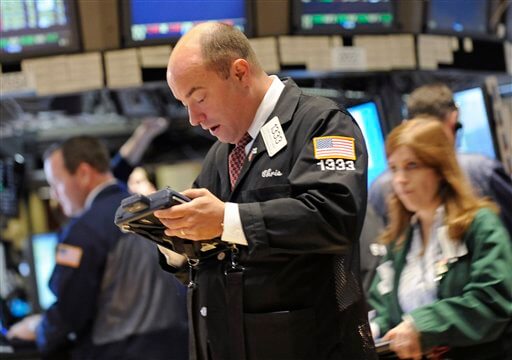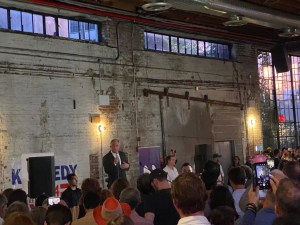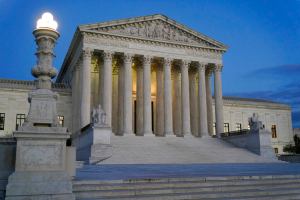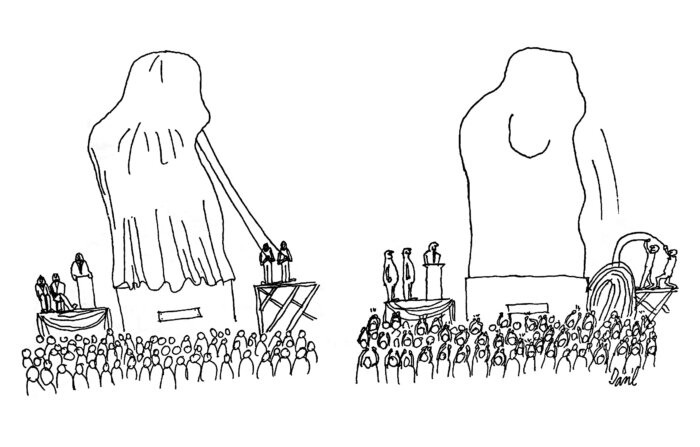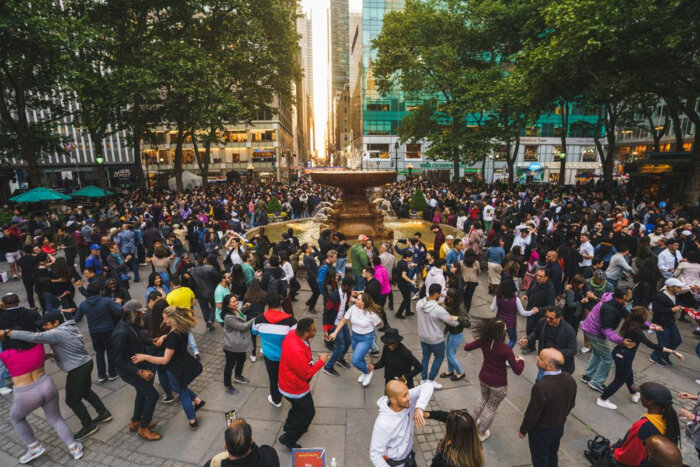
Investors began giving in to fears Thursday that a global recession is already under way, and stock markets shuddered around the world. Selling started in Asia, picked up speed in Europe and sent Wall Street near its worst finish of the year.
The Dow Jones industrial average lost 391 points and at one point was down more than 500, a return to the volatility that gripped the market this summer.
One financial indicator after another showed that investors are losing hope that the global economy can keep growing. The price of oil and metals such as copper, which depend on economic demand, fell sharply. Traders bought Treasury bonds and the dollar for safety.
FedEx, a company that ships so many goods it is considered a barometer of the U.S. economy, had to lower its earnings forecast for the year because customers are putting off purchases of electronics and other gadgets from China.
The Dow fell 391.01 points, or 3.5 percent, and closed at 10,733.83. The selling was not just steep but broad: Nineteen stocks on the New York Stock Exchange fell for every one that rose. At one point, the Dow was down more than 500 points.
“Markets rely on confidence and certainty. Right now there is neither,” said John Canally, an economic strategist at LPL Financial, an investment firm in Boston.
It was the second consecutive rout in the stock market since Wednesday afternoon, when the Federal Reserve announced a change in strategy for fighting the economic slowdown — a bid to lower long-term interest rates and get people and companies to spend more money.
Economic news was bad around the world. A closely watched survey in Europe indicated a recession could be on the way there, and a manufacturing survey suggested a slowdown in China, which has been one of the hottest economies.
“The probability of going back into recession is higher now than at any point in the recovery,” said Tim Quinlan, an economist at Wells Fargo. He put his odds of a recession at 35 percent.
Christine Lagarde, the head of the International Monetary Fund, said the world economy was “entering a dangerous phase.” She told an annual meeting of the IMF and World Bank that nations need credible plans to get their debt under control.
In the United States, investors poured money into American government debt, which they see as less risky than stocks even as the nation wrestles with how to tame its long-term budget problems.
The yield on the 10-year Treasury note hit 1.71 percent — the lowest since the Federal Reserve Bank of St. Louis started keeping daily records half a century ago. It was 3.66 percent as recently as February, when the economic forecast was brighter.
Yields fall as investors buy bonds and send their prices higher. Small yields are a sign that investors are just looking for a safe place to park their cash.
“They want to get their money back,” said Guy LeBas, chief fixed income strategist at Janney Capital Markets. “How much they earn is secondary.”
Besides U.S. bonds, investors bought American dollars. The dollar rose to an eight-month high against the euro because of fears that Europe, staggered by debt, will bear the worst of a global downturn.
The Dow almost matched its lowest close of the year, 10,719 on Aug. 10. The stock market was seized by volatility last month, and at one point the Dow strung together four consecutive days of 400-point moves up or down.
In a sign of what a rocky year it has been for the stock market, Thursday’s decline isn’t even close to the biggest in 2011. The Dow fell 634 points on Aug. 8, 519 points on Aug. 10 and 512 points on Aug. 4.
It would have to fall 485 more points to reach the traditional definition of a bear market — a 20 percent decline. The Dow was at 12,810 on April 29.
The Standard & Poor’s 500 index, a broader measure of the stock market, and the Nasdaq composite, which is more heavily weighted with technology stocks, both fell more than 3 percent for the day.
To get the economy going, President Barack Obama has proposed a $447 billion package of tax cuts, public works projects and benefits for the unemployed, but it faces major opposition in the Republican-controlled House.
While the market was falling Thursday, the president stood in front of an aging bridge that connects Ohio and Kentucky. He exhorted Republicans: “Help us put this country back to work. Pass this jobs bill right away.”
Top Republicans in Congress accused Obama of trying to score political points. If Congress fails to pass the jobs bill, it would leave the Fed action this week as the only major new initiative designed to help the economy.
The Fed announced Wednesday that it would shuffle $400 billion of its own holdings in hopes of reducing interest rates on long-term loans. The plan is known as Operation Twist, a nod to a similar approach taken by the Fed during the time of Chubby Checker in the early 1960s.
The central bank hopes that if people and businesses are able to borrow money more cheaply, they will spend throughout the economy and give it a lift.
Still, the Fed announcement troubled investors because it came with a bleak assessment of the future. The Fed said it sees “significant downside risks to the economic outlook,” including volatility in overseas markets.
“In financial markets, the thinking seems to be: If the Fed is worried, the rest of us ought to be really worried,” said Brian Gendreau, senior investment strategist at Cetera Financial Group.
Economists say the Fed action may help, but probably not much.
“Counting on the Fed to get us out of this is a mistake,” said Uri Landesman, president of Platinum Partners, a hedge fund.
The price of commodities like oil and metals dropped steeply because investors worried that demand for them would fall if the world economy keeps slowing or falls into recession again.
Oil dropped more than $5 a barrel to $80.51, its lowest settling price since Aug. 9. The selling reflected concerns that world demand for oil will fall if the economy slows.
“This is just sudden and strong confirmation that the economy is not improving,” said Michael Lynch, president of Strategic Energy & Economic Research. “Energy demand is going to be very poor.”
The price of silver fell 9.6 percent. And gold fell 3.7 percent. Earlier this summer, gold set one record high after another. Investors wanted it both as a safe place for their money and to cash in on what seemed an unstoppable run. Gold, which was as high as $1,907 two weeks ago, finished at $1,741.70.
Stocks fell sharply even though the New York Stock Exchange executed a rule designed to smooth trading. The exchange invoked Rule 48, which limits how much information is released about stock trades.
Stock volatility rose anyway. The VIX, an index that measures investor fear, rose about 11 percent to 41.35, double the normal level.
It’s common for stocks to move dramatically after the Fed makes a big announcement. But the number of trades that can be made instantly has also gone up in recent years, causing big swings to happen more quickly. Computer systems are programmed to analyze charts, capitalize on tiny changes in price and execute trades with no human intervention.
“These major moves are much more compressed, time-wise, than in the past,” Landesman said. “A 5 percent move can now happen in a couple of minutes as opposed to a week or two.”
Some analysts called the heavy selling an overreaction.
“The facts show we are not in a recession, and we are not borderline recession,” Chris Rupkey, chief financial economist with Bank of Tokyo-Mitsubishi, wrote in a report Thursday.
The U.S. economy grew at an annual rate of 0.7 percent in the first half of this year, the slowest growth since the end of the Great Recession in June 2009. It would take much healthier growth, 4 or 5 percent, to bring unemployment down significantly.
The government reported Thursday that fewer Americans applied for unemployment benefits last week. But the decline wasn’t nearly enough to raise any real hope that the job market is getting better.
Asian stocks were hammered to start the world’s trading. The Nikkei index in Japan fell 2.1 percent. The main stock averages fell 2.8 percent in China, 2.9 percent in South Korea, 2.6 percent in Australia and almost 5 percent in Hong Kong.
Europe fared even worse. The stock market fell 5.3 percent in France, 5 percent in Germany and 4.7 percent in Britain.
___
AP Economics Writers Martin Crutsinger, Christopher S. Rugaber and Paul Wiseman in Washington and AP Business Writer Matthew Craft and AP Energy Writer Chris Kahn in New York contributed to this report.
Copyright 2011 The Associated Press.



